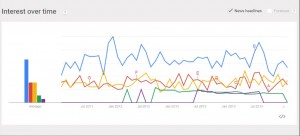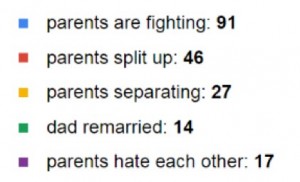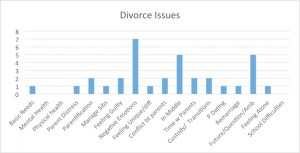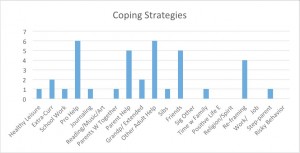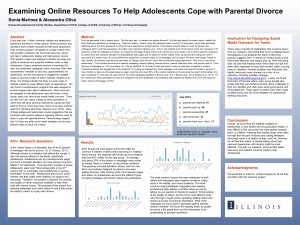Sonia Marinez & Alexandra Oliva
Abstract
Every year over 1 million American children and adolescents experience the divorce of their parents. While counselors and educators have created resources to help these adolescents, most of these programs are geared to younger children. The web provides a powerful way to provide resources, advice and help to adolescents dealing with their parents’ divorce. This research project was designed to identify the range and quality of resources and programs available online to help adolescents. Using a systematic process of searching the web, the researchers catalogued online resources, then rated representative materials on accuracy, appropriateness for adolescents, and the instructional or engagement qualities based on previous studies of online materials (Hughes et al., 2012). The findings indicate that there is a wide range of material created by many different types of organizations. We only found 2 comprehensive programs that were designed to provide programmatic help to adolescents. Most resources are designed to help adolescents cope with stress, school issues, peers and other broad mental health concerns. There are also YouTube videos created by teens themselves in which they talk about personal experiences coping with their parents’ divorce, which have been shown to be teens preferred method of retrieving information (Bowers, et al., 2014). Many of these adolescents’ testimonies provide suggestions that are consistent with research evidence regarding effective ways for teens to cope with parental divorce. These findings suggest that YouTube and other social media strategies are the most effective ways to reach out to teens.
Aim
In the United States it is estimated that 40 to 50 percent of marriages will end in divorce. (U. S. Census, 2011). Although divorce is a situation that affects the couple, it also has serious effects on the family, specifically adolescents. Adolescents are at a developmental stage and such a dramatic situation can have serious long term effects if not addressed. One important question is where adolescents seek help? Most adolescents in the 21stcentury rely on computers and smartphones to access information on the web. Adolescents tend to turn to the internet and their peers when seeking out support and resources. Therefore, we wanted to examine the quantity and quality of online resources available to help them deal with divorce issues. The purpose of this project is to examine webpages and online videos to see if they would be helpful to teens in coping with divorce.
Method
First, we generated a list of search terms. The first term was “my parents are getting divorced”. We then pilot-tested the search terms—added the terms that were generated by Google (e.g., “searches related…{search term} and repeated search process (18 searches)—which then generated additional terms. We then developed a coding format to describe the content and the “instructional” aspects based on work by Bowers and colleagues (2011) and their procedures for coding teen interviews (Bowers et al., 2014). We finalized a list of 100 search terms and conducted 100 searches of both the websites and videos, we copied the first page of each search onto a Document. We compile a list of all the searches organized by search term and randomly sampled (no duplicates) 30 web pages and 30 videos for further coding. Then we pilot test the coding form with 2 documents & 2 videos (each of us) and refined the coding form to finalize coding for 30 webpages and 30 videos. We then used Google Trends to help identify 15 searches that had some popularity on Google (note: we don’t know who is searching using these terms. They may or may not be adolescents.)
Google Search Trends of 15 popular search terms from July 2014-Present
This included terms such as parents separating, parents fighting, parents’ divorce, parents hate each other, and parents split up. From this pool of webpages (n =121) and videos (n= 118) we identified 10 (of each) to read and watch in order to code them in regards to content, instructional design and engagement of the audience. For coding we selected only those webpages and videos that seemed at least in general to have children or teens as the target audience (again note that only about 50% of the random materials we found using the search terms yielded this type of material). For this step we used some of the coding strategies identified in Bowers et al., 2011; Bowers et al., 2014; Hughes et al., 2012). For the content and coping strategies we used the categories that were developed from qualitative data collected by Bowers et al.2014 and coded by Hollis, Smith and Herdegen (2015).
Results
Implication for Designing Social Media Outreach for Teens
There were a handful of implications that could be drawn from our research. One being that much of material found that appears to be designed for teens of divorcing parents is not for them. It seems as if teens trying to find from these searches and maybe give up. With that being said, we saw that reading levels were often too high and were often organized in ways that wouldn’t catch a young person’s attention. Another problem was that some very helpful resources never showed up in any of our searches, including Families Changes (http://teens.familieschange.ca.gov/). Lastly, we found that many of the best videos were young people who simply told their own personal stories about challenges in their own families and often gave some good advice and encouragement. These types of videos were often made by fellow teens and are more relatable for adolescents seeking resources.
Even though we used search terms that might be common if children or teens were searching for material about divorce, the searches still turned up much material that was NOT written for this age group. On average, only about 50% of the videos or webpages were coded as having “teens or children” as the primary audience. The searches included television shows, ads from law firms, and material designed for parents who were getting divorced. After looking at the most relevant pages and videos for adolescents we found the different types of coping strategies and divorce issues they addressed.
The most common issues that were addressed in both videos and webpages were negative emotions, being stuck in the middle, and future questions.
The most common coping strategies suggested were seeking professional help, talking to another adult, as well as talking to your parents or friends for support.
When looking at the design of videos, we found the most effective ones were through a single person speaking (talking head) who shared accounts of personal information. Most of the webpages we found weren’t generally geared towards children however. We found the reading levels to usually be above a 8th grade level and the information to be unappealing to younger audiences.
Conclusions
Overall, we found that the material available to adolescents is very limited and not particularly helpful. It was difficult to find resources that were geared towards teens or children, meaning that reading levels were often too high and the type of issues and coping strategies discussed weren’t as helpful as they could be. However, we did find that videos of people talking about their personal experiences with divorce might be most effective. Through our research, we found that better resources and material could be made to help adolescents.
Acknowledgments
We would like to thank Dr. Robert Hughes for all his help and effort with this research project.
Citation: Marinez, S., & Olivia, A. (April, 2015). Examining Online Resources To Help Adolescents Cope with Parental Divorce. Poster presented at the annual Undergraduate Research Symposium, University of Illinois at Urbana-Champaign, Urbana, IL.


